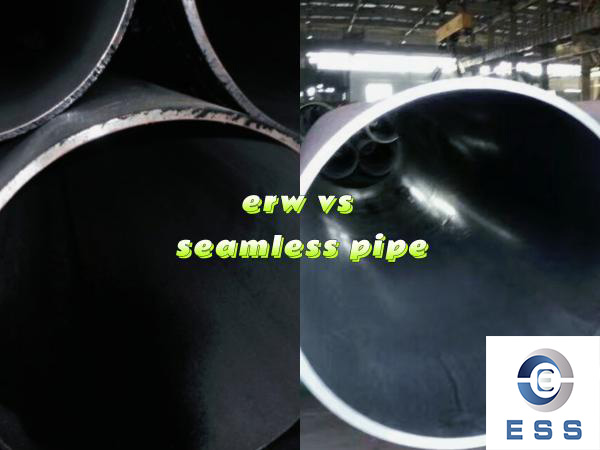ERW vs seamless pipe in weight calculation
What are seamless pipes?
Seamless steel pipe is a long strip of steel with a hollow section and no seams around it. It is made of steel ingots or solid tube blanks through perforation and then hot-rolled, cold-rolled or cold-drawn.
Seamless steel pipe uses:
The application of seamless steel pipes mainly reflects three major fields. One is the construction field, which can be used for underground pipeline transportation, including groundwater extraction when building buildings. The second is the processing field, which can be used in mechanical processing, bearing sleeves, etc. The third is the electrical field, including pipelines for gas transmission, fluid pipelines for water power generation, etc.
For example, seamless steel pipes are used in structures, fluid transportation, low and medium pressure boilers, high pressure boilers, fertilizer equipment, petroleum cracking, geological drilling, diamond core drilling, oil drilling, ships, automobile half-shaft casings, diesel engines, etc. The use of seamless steel pipes can avoid problems such as leakage, ensure the use effect, and improve material utilization.
Seamless pipe weight calculation
Seamless steel pipe weight per meter W=0.02466*S(D-S)
Symbolic meaning:
W: Theoretical weight of steel pipe kg/m
D: Nominal outer diameter of steel pipe mm
S: Nominal wall thickness of steel pipe mm
Calculation example:
For a seamless steel pipe with an outer diameter of 60mm and a wall thickness of 4mm, find the weight per m.
Weight per m=0.02466*4*(60-4)=5.52Kg

What are ERW pipes?
"ERW steel pipe" is a straight seam electric resistance welded pipe, which is used to transport vapor and liquid objects such as oil and natural gas. It can meet various requirements of high and low pressure and plays a decisive role in the field of transportation pipes in the world. ERW pipe is a "high-frequency resistance welded steel pipe". It is different from the welding process of ordinary welded pipes. The weld seam is melted from the base material of the steel strip body, and its mechanical strength is better than that of ordinary welded pipes.
ERW stands for resistance welding. Resistance welding has the characteristics of high production efficiency, low cost, material saving, and easy automation. Therefore, it is widely used in various industrial sectors such as aviation, aerospace, energy, electronics, automobiles, and light industry. It is one of the important welding processes. one.
The biggest difference between ERW steel pipes and seamless steel pipes is that ERW has a weld seam, which is also the key to the quality of ERW steel pipes. Modern ERW steel pipe production technology and equipment, thanks to years of unremitting efforts internationally, especially in the United States, have made the seamlessness of ERW steel pipes more satisfactory. Some people divide the seamlessness of ERW steel pipes into geometric seamlessness and physical seamlessness. Geometric seamlessness is to remove the internal and external burrs of ERW steel pipes. Due to the continuous improvement and improvement of the structure of the internal burr removal system and the cutting tools, the internal burrs removal of large and medium-diameter steel pipes has been better handled. The internal burr can be controlled at about -0.2mm~O.5mm. Physical seamlessness refers to the difference between the metallographic structure inside the weld and the base metal, resulting in a decrease in mechanical properties in the weld area, and measures need to be taken to make it uniform and consistent.
The high-frequency welding heat process of ERW steel pipes causes a temperature distribution gradient near the edge of the tube blank, and forms characteristic areas such as melting zone, semi-melting zone, overheated structure, normalizing zone, incomplete normalizing zone, and tempering zone. In the superheated zone structure, due to the welding temperature above 1000°C, the austenite grains grow rapidly, and a hard and brittle coarse grain phase will be formed under cooling conditions.
In addition, the existence of temperature gradient will generate welding stress. In this way, the mechanical properties of the weld area are lower than those of the base metal. The physical seamlessness is achieved through the local conventional heat treatment process of the weld, that is, using a medium frequency induction heating device to heat the weld area to AC3 (927°C), and then conduct 60m Air cooling process with length and speed of 20m/min, followed by water cooling when necessary. The use of this method achieves the purpose of eliminating stress, softening and refining the structure, and improving the comprehensive mechanical properties of the welding heat-affected zone. So far, the world's advanced ERW units have generally adopted this method to process welds, and have achieved good results. High-quality ERW steel pipes not only cannot identify the weld, but also have a weld coefficient of 1, achieving a match between the structure of the weld area and the base material.
ERW weight calculation
Weight of welded steel pipe kg/m = (Od - Wt) ×Wt× 0.02466 Note: Od is the outer diameter and Wt is the wall thickness
Note: The nominal diameter can be expressed in metric mm or inch in.
Read more: Difference between seamless pipe and seam pipe













 Eastern Steel Manufacturing Co.,Ltd not only improve product production and sales services, but also provide additional value-added services. As long as you need, we can complete your specific needs together.
Eastern Steel Manufacturing Co.,Ltd not only improve product production and sales services, but also provide additional value-added services. As long as you need, we can complete your specific needs together.










